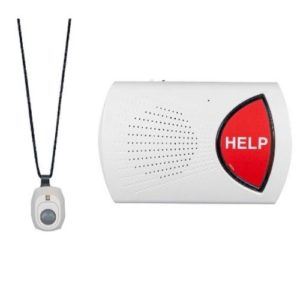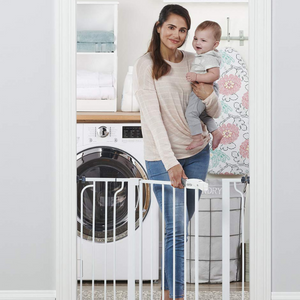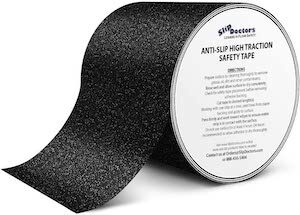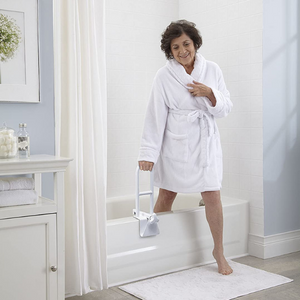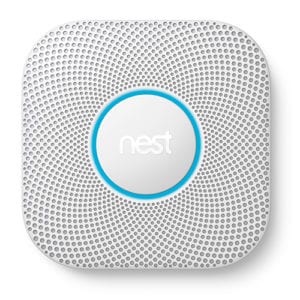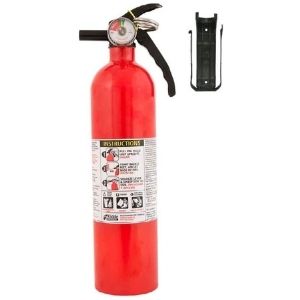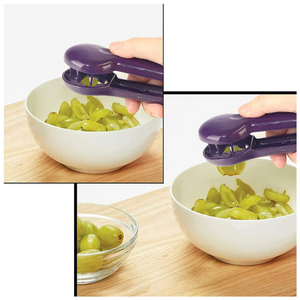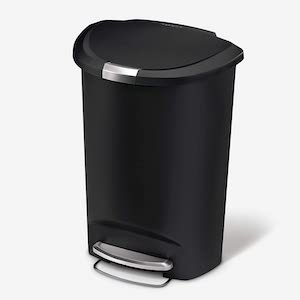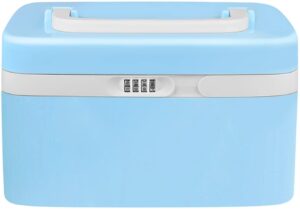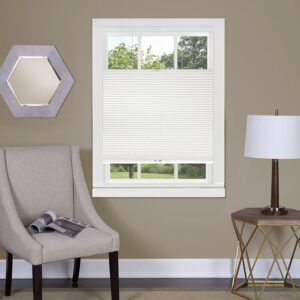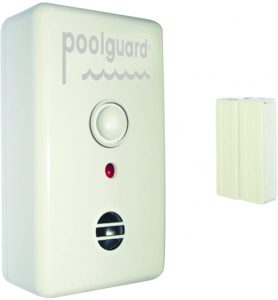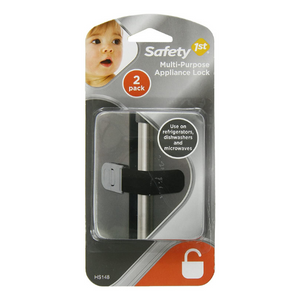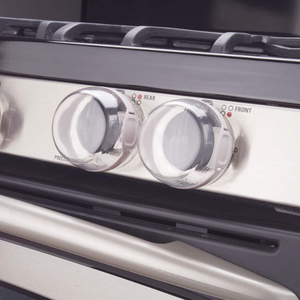Reviewed by health expert Sally Russell, MN, CMSRN, CNE
Safety Hazards to Watch for Around the House
For over 11 years, SafeWise experts have conducted independent research and testing to write unbiased, human reviews (not robots). Learn more.
Creating a safe home environment where your family can grow and thrive is a top priority. Thankfully, though a number of serious safety hazards lurk around the average home, most of these concerns are pretty easy to address.
Make sure you’re doing everything you can to achieve maximum home safety. Consult this guide of nine common safety hazards around the home to learn quick and simple solutions for keeping you and your loved ones out of harm’s way.
Sign up for our free weekly newsletter to get the best safety news, product info, and deals.
By signing up, you agree to our Terms and Conditions and Privacy Policy.
Watch out for these home safety hazards

1. Falls
Injuries due to falls are one of the most common hazards at home. In fact, one out of five older adults who falls incurs a broken bone or a head injury.1 Wet floors, slippery stairs, and scattered toys all create the potential for falls.
Read more about how removing hazards around the home in our Room-by-Room Guide to Senior Safety.
Get a medical alert system
In the event of a fall, a medical alert system provides older adults a button they can push for assistance during an emergency. The help button is usually worn as a pendant or wristband, but you can also place buttons on the walls throughout your home.
These buttons can be monitored or unmonitored. We recommend Bay Alarm Medical as the best overall medical alert system because it balances quality, variety, and affordability.
Stabilize staircases
*Amazon.com price as of publish date. Read full disclaimer.
To prevent falls, make sure all staircases have solid handrails, securely affixed flooring, adequate lighting, and safety gates if there are small children in the home. The Regalo Easy Step Walk Thru Gate is adjustable to most spaces and easy to use, even with a baby in your arms. Check out our lists of best baby gates and best pet gates for more options.
Finally, be sure to keep the stairs clear of any tripping hazards. It's tempting to put things like laundry near the stairs to put away on your next trip up or down, but those can also be easy to pass up and trip over when you're in a rush.
Clear outdoor steps
*Amazon.com price as of publish date. Read full disclaimer.
Keep all outside stairs clear of debris and hazards like ice and snow. Secure fix mats in place or use grip tape like SlipDoctors Anti-Slip Safety Tape to make surfaces less slippery.
Cover slippery surfaces in bathrooms
To improve bathroom safety, secure rugs to avoid slipping and to prevent water from pooling on slick surfaces. Non-slip stickers like SlipX Solutions Safety Treads are a particularly good way to keep everyone in your home from slipping in the shower.
Install supports showers and bathtubs
*Amazon.com price as of publish date. Read full disclaimer.
Install safety rails like the Medline Bathtub Grab Bar to help family members old and young safely get in and out of the shower. Or use a Changing Lifestyles Safe-er-Grip Balance Assist Bar, which is small enough to fit in any shower. You can add more than one to provide extra support to older family members and others who need additional help.
Corral toys
Even a small toy can be a tripping hazard. Give the kids an easy way to stow toys and make sure every playdate ends without injury. Secure skateboards, bikes, and other mobile toys in a safe area where family members and visitors won’t trip on them.
2. Fires
One key to home safety is fire prevention. In 2020, there were more than 356,500 fires in US homes, causing everything from mild smoke damage to total devastation, including the loss of 2,630 lives.2 Even candles or an unattended iron can lead to accidental fires in your home, but there is a lot you can do to prevent a home fire from starting or getting out of hand. Learn more from our fire prevention guide.
Install fire alarms
*Amazon.com price as of post date. Read full disclaimer.
Install fire alarms on all levels of your home, and check and change the batteries at least annually for better fire safety. Consider investing in a smart smoke detector like Google Nest Protect†.
This alarm uses Wi-Fi to provide real-time updates. And you can access remote monitoring right on your smartphone or other mobile device.
If you don't want a mobile app on your smoke alarm, consider getting a non-connected model like the Kidde Smoke and Carbon Monoxide Detector Alarm with Voice Warning.
Monitor candles
Never leave unattended candles or use them near loose cloth like drapes or blankets. Also, make sure this fire hazard stays out of reach of children and that pets can’t knock them over.
Buy a fire extinguisher
*Amazon.com price as of publish date. Read full disclaimer.
Keep at least one fire extinguisher in your home—and check it annually to make sure it's in good working order. Keep a multi-purpose fire extinguisher, like the Kidde FA110, handy in the kitchen or near the fireplace.
Here are some more fireplace safety tips.
Unplug unused appliances
Avoid electrical fires by making sure that all appliances around the home are in good working order and no wires are frayed. Don’t overload electrical outlets, either. In fact, it’s a smart electrical safety practice to unplug small appliances like toasters when not in use.
3. Carbon monoxide
Another potential danger in the house is carbon monoxide. Low exposure to carbon monoxide (CO) can cause headaches and dizziness, while high levels can lead to vomiting, impaired vision, and even death.
Carbon monoxide is virtually impossible to detect by smell, sight, or sound, making it a difficult threat to discern. But there are things you can do to ward off CO poisoning.
Install a CO detector
*Amazon.com price as of post date. Read full disclaimer.
You can help keep your family safe by installing a carbon monoxide detector that alerts you if CO reaches dangerous levels in your home. A detector that plugs into an electrical outlet, like the Kidde Nighthawk Alarm, provides extra reassurance and saves you from needing to change batteries. And combination smoke and carbon monoxide detectors like Google Nest Protect pull double-duty.
Keep up with home maintenance
Prevent carbon monoxide leaks by having a professional service your HVAC system, water heater, and other appliances that use gas, oil, or coal at least once a year. If you’re buying an older home, have a professional inspect these systems before purchase so you can fix problems before moving in. You can look up licensed professionals in your area using Thumbtack.
Watch our video about Carbon Monoxide detectors
Subscribe to our Youtube channel and learn how to protect your home, loved ones, and belongings.
4. Choking
Choking is the fourth-largest cause of accidental death in the US, claiming 3,000 victims in 2020.3 From a bite of dinner going down the wrong way to a young one accidentally swallowing a small item, choking is scary. Educate yourself with these safety tips about choking hazards, and take measures to keep your family safe.
Inspect toys
Regularly inspect toys for any loose parts. Give age-appropriate toys to ensure there are no small parts. Scour floors for small toys or items where little hands might easily find them.
Learn more about hazards to watch out for in play rooms and nurseries.
Keep choking hazards out of reach
Be sure to keep small, hard foods like nuts or candies out of reach of children. Pay special attention at adult gatherings where children can more easily sneak something unnoticed.
Monitor playtime
Even if your child is no longer an infant, a baby monitor can still come in handy. Use this gadget to listen in for signs of choking when children are playing in another room.
Cut up food
*Amazon.com price as of publish date. Read full disclaimer.
For children under the age of four, always cut up hard foods that can block airways. The same applies to softer foods like grapes, cherry tomatoes, and hot dogs. A grape slicer is a handy tool that makes safe snacking easier for you and your toddler.
5. Cuts
This one seems like a no-brainer, but unfortunately there are a number of common items with sharp edges inside and outside your home. Everything from an open food can to a garden hoe can be dangerous.
Close the trash can
*Amazon.com price as of publish date. Read full disclaimer.
Use a locking garbage can to protect small fingers and pets from finding sharp edges on open food cans and lids. We suggest something like this product from Simplehuman, an attractive solution that adds an extra layer of kitchen safety.
Store kitchen tools properly
Knives, graters, and peelers are common items that can lead to nasty cuts. Properly store all sharp kitchen tools and lock them up if you have small children in the home.
Learn more about kitchen safety tips for kids.
Lock up bathroom sharps
If you use a razor, keep it on a high shelf or lock it in a cabinet. Store extra blades in drawers with safety guards and safely stow other grooming tools like cuticle scissors as well.
Child safety locks are easy to install around the home and keep little fingers away from unintentional injury.
Point knives and forks down in the dishwasher
Keep little ones safe from sharp points by pointing knives and forks downward in the utensil basket of the dishwasher. Place the basket away from the front of the dishwasher to make sharp objects even less accessible.
Put away yard tools
Lawn tools, including rakes, saws, and lawnmowers, can cause harm if not used and stored properly. Stay alert when using power tools, and never rush while mowing the lawn or using the weed whacker. Never leave tools lying around. Always keep them locked in a shed or garage where kids can’t access them.
6. Poisoning
There were over two million poisoning incidents reported to poison control centers nationwide in 2020.4 Several household items present poisoning hazards, including cleaning and home maintenance supplies.
However, a little diligence and poison-proofing can decrease the chance of accidental poisoning in your family.
Store medications properly
*Amazon.com price as of publish date. Read full disclaimer.
Both over-the-counter and prescription medications can prove extremely hazardous to children and teens. Dispose of all unused medications, and never leave them out on a counter. Solutions like the locking Eoere Medicine Cabinet are a convenient way to keep medications handy without making them vulnerable to accidental discovery.
Keep paint out of reach
Even paint that isn’t lead based needs proper storage to stay out of reach of children. Never put paint in a container other than the one it came in. Otherwise, your child may mistake it for a drink or something else.
Secure all chemicals
Protect both children and pets from accidental poisoning by securing your cleaning supplies. Keep all household cleaners in a high cupboard with a safety lock to keep kids and animals from accidentally finding them. Lock up pesticides and items like turpentine in a cupboard or lockbox in the garage or shed.
Put away personal care products
Keep all makeup, hair products, soaps, and other personal products out of the reach of children and pets. Use safety latches on all doors and drawers to help keep even the most determined youngsters out.
Lock up detergent
As with all household cleaners, lock laundry and dishwasher detergents out of reach of pets and kids. If you use detergent pods, make sure children don’t mistake them for candy. Never fill the soap dispenser until you’re ready to start a load and always check your dishwasher for leftover residue after each cycle.
7. Strangling
Cords on window dressings like blinds or curtains present a common strangling hazard to small children and infants.5 Here are three ways you can help make your home safer for little ones.
Put away cords
Keep window and electrical cords out of reach of little ones. Never place a crib or bed under a window with dangling cords. If you use an extension cord, make sure to put it away after it’s no longer needed.
Trim or remove window cords
*Amazon.com price as of publish date. Read full disclaimer.
To keep children from tangling themselves up, trim cords to a length that is only accessible to the adults in the home. Better yet, trade out window treatments for designs without cords.
If you like the look of blinds, make your windows attractive and safe with Achim Home Furnishings Cordless Pleated Shades.
Wrap up blind cords
If you’re not ready to redecorate, you can make your home safe by installing blind cord wraps to your current window coverings. Dreambaby Blind Cord Wraps are affordable, easy to install, and transparent, so they won’t clash with your decor.
8. Drowning
Drowning isn’t only a risk when swimming or playing in water outside—it can also present a hazard in the home. On average, two-thirds of childhood drownings under the age of one occur in a bathtub,6 so do your part to prevent drowning with these two tips:
Put away buckets
If you use buckets for cleaning, keep them empty and away from water sources.
Attend to bathing children
It only takes a few inches of water for a child or infant to drown, so never leave a child alone in the bathtub, and always close the toilet lid. Learn more in our child bathroom safety guide.
Keep your pool safe and secure
*Amazon.com price as of post date. Read full disclaimer.
Keep pool safety equipment handy at all times, like a drowning hook and a life buoy. Fence the pool completely, lock it securely, and monitor it with gate, motion, and water break alarms, like the Poolguard DAPT-2 Gate Alarm.
You can also add a sensor to the pool gate with a DIY home security system like SimpliSafe so that you will get an alert on your phone if someone enters the pool area when you're not around.
Info current as of post date. Offers and availability may vary by location and are subject to change.
Make sure children are always supervised by an adult when swimming, and adopt a zero-tolerance policy for running or rough housing on the pool deck.
Learn how to recognize drowning
If your child slips under the water, knowing how to react can save their life. But drowning doesn't always look obvious. Take a class from your local Red Cross to recognize drowning and learn rescue techniques like CPR.
*Amazon.com price as of publish date. Read full disclaimer.
Make sure your dishwasher latches securely at all times to prevent curious fingers from opening the door, particularly at the end of a cycle when burns from steam are most likely to occur. Add the Safety 1st Appliance Lock as an extra measure to keep stop accidental dishwasher access.
Use the back burners
Around 180,000 deaths each year are caused by burns.7 To prevent burns, use the back burners on your stove when possible. This makes it more difficult for kids to accidentally touch a hot stovetop. Never rest tempting items like cookies or toys on the stovetop, even when it’s not in use.
Add stove knob covers
*Amazon.com price as of publish date. Read full disclaimer.
Stoves—especially gas ones—are the perfect place for something to accidentally catch on fire. Protect your home from a potential fire by adding stove knob covers, like these from Safety 1st. They keep small hands from turning on burners or grownups from inadvertently knocking burners to the “on” position.
Final word
Nothing is more important than keeping your family safe. Knowing which precautions to take makes your job as family protector a little easier, but no one can be on duty all the time.
You may want to get some help protecting your loved ones with a monitored security system. Most current systems offer home automation and remote access so you can make sure everything is okay as often as you want.
Related articles on SafeWise
Sources
- Centers for Disease Control and Prevention, "Important Facts about Falls," August 6, 2021. Accessed August 29, 2022.
- National Fire Protection Association, "Fire Loss in the United States in 2020." August 29, 2022.
- National Safety Council, "Choking Prevention and Rescue Tips." August 29, 2022.
- National Capital Poison Center, "Poison Statistics National Data 2018." August 29, 2022.
- Consumer Product Safety Commission, "Window Covering Cords Information Center." August 29, 2022.
- CDC, "Drowning Facts," March 10, 2022. August 29, 2022.
- World Health Organization, "Burns," March 6, 2018. August 29, 2022.
Disclaimers
Product prices and availability are accurate as of the date/time indicated and are subject to change. Any price and availability information displayed on Amazon at the time of purchase will apply to the purchase of this product. Safewise.com utilizes paid Amazon links.
Certain content that appears on this site comes from Amazon. This content is provided “as is” and is subject to change or removal at any time.
†Google Nest Protect, Google Nest, Google, and other related marks are trademarks of Google LLC.
Recent Articles






